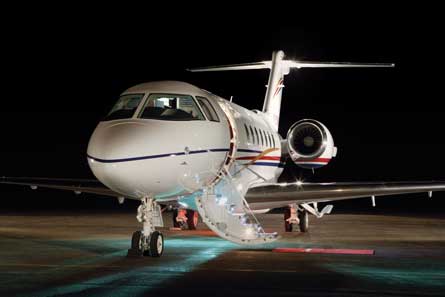'Paper' exercise sees super mid-size business jet's cabin payload increase to 870kg
Raytheon Aircraft plans to increase the lifting capability of the new Hawker 4000 super mid-size business jet by about 590kg (1,300lb) starting with the 20th production aircraft, scheduled for completion next October.
The gain, which Raytheon Aircraft president Brad Hatt describes as a "paper" exercise, boosts the aircraft's full-fuel cabin payload from just 285kg on the first 14 aircraft to 870kg on serial number 20 and beyond.
First delivery for the eight-passenger, Pratt & Whitney Canada PW308A-powered twinjet is scheduled for March. Serial number 6 will be delivered to fractional provider NetJets, the launch customer, and will be used for coast-to-coast work and US-Hawaii routes. Until then, Raytheon is using the aircraft as a demonstrator.
|
|---|
First delivery of the eight-passenger Hawker 4000 is scheduled for March |
The first five Hawker 4000s, the aircraft formerly known as the Horizon, were used for flight testing and certification. NetJets has orders for 50 of the $19.95 million aircraft over the next seven years, says Hatt. Raytheon plans to build 24 aircraft at its Wichita plant next year, ramping up to 30 aircraft a year starting in 2008. Hatt says the factory is currently loaded through to serial number 19.
The company is in the process of obtaining its production certificate and approval for flight into known icing, and is working on fuel and hydraulic system items exempted when the Federal Aviation Administration approved the aircraft's type certificate in November. It has until 1 June 2007 to test, validate and retrofit hydraulic system components to withstand higher pressures, and has until 1 September 2008 to complete a fuel system safety analysis and incorporate any changes needed to prevent ignition of vapours.
Both requirements came in after the company had begun its certification efforts, although the FAA required it to comply in order to have the application period extended to the end of the calendar year after delays scuttled earlier certification target dates.
Hatt says the gross weight increase is likely to be just a paperwork exercise as the aircraft was tested to 18,340kg maximum gross weight - 1,225kg more than the maximum certificated gross weight of 17,120kg - without having to strengthen the wing structure or landing gear. For aircraft delivered before serial number 20, the increased maximum weight will be handled by a change to the flight manual, he says.
Source: Flight International
























